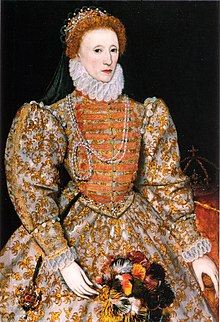The English royal patent prerogative reached its high-point with the end of the Tudor Dynasty (Queen Elizabeth I) and the beginning of the Stuart, when "Parliament wrung the Statute of Monopolies out of King James I"[1], in 1624, just before his death in 1625.
[1] Floyd L Vaughan, The United States Patent System 15 (1986).
 |
| Queen Elizabeth I - Believer in Strong Patent Rights? Jury Still Out! |
The Virgin Queen cherished her patent prerogative. Her extensive use of the prerogative to favor select courtiers and petitioners has been written about for centuries.
Elizabeth's disputes with Parliament over her use of the prerogative, unfulfilled promises on the Queen's part to limit their use, and her reported dismissal of Parliament when it tried to limit her use of the prerogative [2] , would set the stage for James' I's concession of the Statute of Monopolies, which most historians peg as the beginning of the modern patent era (the Republic of Venice's patent statute notwithstanding).
What gets lost in the centuries to many writer's, however, is that Elizabeth's "patent" abuses were primarily concerned with the granting of business and importation monopolies. Her granting of patents in the modern sense of the term, i.e., patents for new inventions, was (and remains) far less controversial.
But, to me, all that is besides the point.
Few, if actually, anyone, including those great Elizabethan-era writers, Shakespeare or Marlowe, or the Victorian-era Dickens (in his "Poor Man's Tale of a Patent") ever spoke as poetically about patents as Good Queen Bess does in just one sentence.
The Queen said that the royal patent prerogative:
was the chiefest flower in her garden and the principal and head pearl in her crown and diadem.[2]In my opinion, unmatched.
Of course, I had no idea what a diadem was and had to look it up.
[2] E. Burke Inlow, The Patent Grant at 21 (citation omitted).
Update:
I cannot believe, but I have found the use of the word "diadem", in another patent context. This time in the patent for the Statue of Liberty (USD11023: 1879).
In the patent, it says:
What I claim as my invention is the herein-described design of a statue representing Liberty enlightening the world, the same consisting, essentially. of the draped female figure, with one arm upraised, bearing a torch, while the other holds an inscribed tablet. and having upon the head a diadem, substantially as set forth. (emphasis added).
 | |
| Lady Liberty's Seven Rayed Diadem |
**
No comments:
Post a Comment